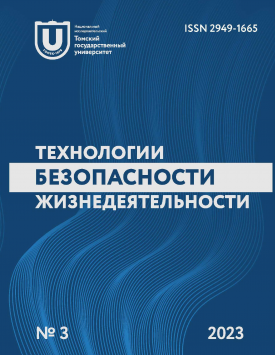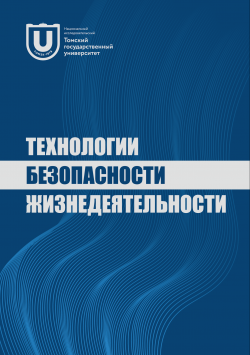The study of the antibacterial properties of protective paint coatings based on the biocide nanoparticles with non-specific effect on highly pathogenic bacterial strains
Nanotechnologies are increasingly being used as modern methods of combating pathogenic microorganisms in the healthcare sector. Nanoparticles of some metal oxides can have an antibacterial effect, while at the same time remaining safe for cells and tissues of the human body. In this work, we conducted a study of the antibacterial properties of paint and varnish protective coatings created on the basis of a concentrate of ZnO-Ag nanoparticles of relatively highly pathogenic strains of bacteria. As a result, complete inactivation of highly pathogenic strains of bacteria was observed on the surface of the paint and varnish material and paint and varnish composition, including a concentrate of ZnO-Ag nanoparticles. Thus, the coatings under study have antibacterial properties in accordance with R 4.2.3.676-20 and can be used as a means of non-specific protection against the threat of the spread of pathogenic organisms.The authors declare no conflicts of interests.
Keywords
ZnO-Ag nanoparticles,
antibacterial coatings,
paintwork materials and compositions,
antibacterial activity,
biosafetyAuthors
| Prokopchuk Anna O. | Tomsk State University | bio_1979@mail.ru |
| Bakina Olga V. | Tomsk State University | ovbakina@ispms.ru |
| Lerner Marat I. | Tomsk State University | lerner@ispms.ru |
| Pikushchak Elizaveta V. | Tomsk State University | pikushchak@gmail.com |
| Alekseev Alexander Yu. | Federal Research Center for Medical and Technical Medicine | ayalekseev@frcftm.ru |
| Skorupo Anna S. | Federal Research Center for Medical and Technical Medicine | skorupo.anna@yandex.ru |
| Evplonova Elena S. | JSC “Association “Yaroslavskie kraski” | ntc2@yarkraski.ru |
| Yakovlev Nikolai V. | JSC “Association “Yaroslavskie kraski” | yakovlev@yarkraski.ru |
| Vorozhtsov Alexander B. | Tomsk State University | abv1953@mail.ru |
Всего: 9
References
World Health Organization, Global Action Plan on Antimicrobial Resistance. 2015. URL: https://www.who.int/antimicrobial-resistance/global-action-plan/en.
Andersson D.I., Balaban N.Q., Baquero F., Courvalin P. et al. Antibiotic resistance: turning evolutionary principles into clinical reality // FEMS Microbiology Reviews. 2020. Vol. 44 (2). Р. 171-188. 10. 1093/femsre/fuaa001.
Qian M., Xu D., Wang J., Zaeim D., Han J., Qu D. Isolation, antimicrobial resistance and virulence characterization of Salmonella spp. from fresh foods in retail markets in Hangzhou, China // PLoS One. 2023. Vol. 18 (10). Art. № e0292621.
Park J.-H., Kim Y.-J., Binn K., Seo K.-H. Spread of multidrug-resistant Escherichia coli harboring integron via swine farm waste water treatment plant // Ecotoxicology and Environmental Safety. 2018. Vol. 149. Р. 36-42.
Christaki E., Marcou M., Tofarides A. Antimicrobial resistance in bacteria: mechanisms, evolution, and persistence // Journal of molecular evolution. 2020. Vol. 88 (1). Р. 26-40.
Coates A.R.M., Halls G., Hu Y.M. Novel classes of antibiotics or more of the same? // British Journal Pharmacology. 2011. Vol. 163. Р. 184-194.
Dutta R.K., Nenavathu B.P., Gangishetty M.K., Reddy A. V. Studies on antibacterial activity of ZnO nanoparticles by ROS induced lipid peroxidation // Colloids Surfaces B: Biointerfaces. 2012. Vol. 94 (1). Р. 143-150.
Sadiq I.M., Chandrasekaran N., Mukherjee A. Studies of effect of TiO2 nanoparticles on growth and membrane permeability of Escherichia coli, Pseudomonas aeruginosa and Bacillus subtilis // Current Nanosciense. 2010. Vol. 6. Р. 381-387.
Kumar A., Pandey A.K., Singh S.S., Shanker R., Dhawan A. Cellular response to metal oxide nanoparticles in bacteria // Journal of Biomedical Nanotechnology. 2011. Vol. 7. Р. 102-103.
Kumar A., Pandey A.K., Singh S.S., Shanker R., Dhawan A. Engineered ZnO and TiO2 nanoparticles induce oxidative stress and DNA damage leading to reduced viability of Escherichia coli // Free Radical Biology and Medicine. 2011. Vol. 51. Р. 1872-1881. 10.1016/j. freeradbiomed.2011.08.025.
Ansari M.A., Khan H.M., Khan A.A., Cameotra S.S., Saquib Q., Musarrat J. Interaction of Al2O3 nanoparticles with Escherichia coli and their cell envelope biomolecules // Journal of Applied Microbiology. 2014. Vol. 116. Р. 772-783. 10.1111/jam. 12423.
Agarwala M., Choudhury B., Yadav R.N.S.Comparative study of antibiofilm activity of copper oxide and iron oxide nanoparticles against multidrug resistant biofilm forming uropathogens // Indian Journal of Microbiology. 2014. Vol. 54. Р. 365-368.
Xie Y., He Y., Irwin P.L., Jin T., Shi X. Antibacterial activity and mechanism of action of zinc oxide nanoparticles against Campylobacter jejuni // Applied and Environmental Microbiology. 2011. Vol. 77 (7). Р. 2325-2331.
Ali A., Phull A.R., Zia M. Elemental zinc to zinc nanoparticles: is ZnO NPs crucial for life? Synthesis, toxicological, and environmental concerns // Nanotechnology Reviews. 2018. Vol. 5 (7). Р. 413-441.
Sondi I., Salopek-Sondi B. Silver nanoparticles as antimicrobial agent: a case study on E. coli as a model for Gram-negative bacteria // Journal of Colloid and Interface Science. 2004. Vol. 275. Р. 177-182.
Morones J.R., Elechiguerra J.L., Camacho A., Holt K. et al. The bactericidal effect of silver nanoparticles // Nanotechnology. 2005. Vol. 16 (10). Р. 2346-2353.
Jung W.K., Koo H.C., Kim K.W., Shin S. et al. Antibacterial activity and mechanism of action of the silver ion in Staphylococcus aureus and Escherichia coli // Applied and environmental microbiology. 2008. Vol. 74 (7). Р. 2171-2178.
Закс Л. Статистическое оценивание. М.: Статистика, 1976. 598 с.
Бакина О.В., Чжоу В.Р., Иванова Л.Ю., Казанцев С.О. Влияние содержания металлического серебра в наночастицах ZnO-Ag на их фотохимическую и антибактериальную активность // Журнал неорганической химии. 2023. T. 68, № 3. С. 401-410.
Dove A.S., Dzurny D.I., Dees W.R., Qin N. et al. Silver nanoparticles enhance the efficacy of aminoglycosides against antibiotic-resistant bacteria // Frontiers in Microbiology. 2023. Vol. 13. Art. № 1064095.

